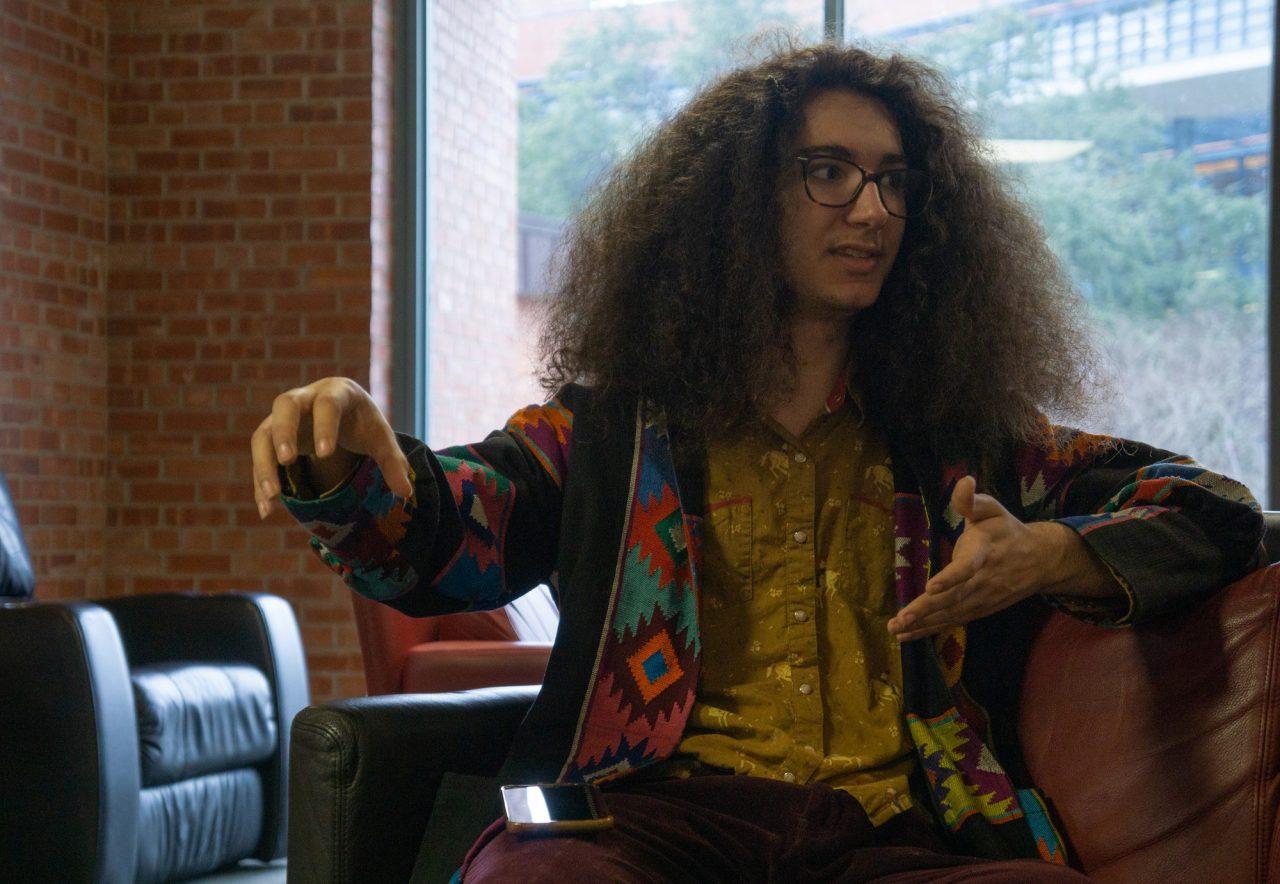Photo by Kate Nuelle
Marlin Guerra-Bogle is a sophomore at Trinity who studies Anthropology. Additionally, he is engrossed in photography and performance art and is a part of the experiment performance art collective called “Black Sheep.” They are an avant-garde group whose exhibitions are a mixture of paintings, installations, short films and audience integration.
What projects have you worked on that are most important to you?
I’m in an artist group called Black Sheep. To me, it’s an important way of staying in contact with other artists and other mediums of art. We mostly do paintings or sculptures or performance art. We just finished a Valentine’s Day show on Friday, and I was doing performance art for that one. I was in costume, and I was doing a character. I think that most people probably wouldn’t consider that art in the same way, but to me, it feels just like another medium of art.
How did you get involved in the Black Sheep group?
I have a friend from high school that’s involved with the group and so I knew of them. Last year, I had an anthropology project where I had to find a subculture and write an ethnography on them, and I chose the artists’ subculture that Black Sheep was a part of. When I was working on that, I got to know them very well. Then I kind of got drafted into one of their performances, and then after the project ended I kept hanging out with them and I eventually just became a member of the group.
What was the premise of the performance art for your most recent show?
It was really abstract. I basically just had a character and I was going around acting the way I thought the character would act. I know it was kind of a crazy character and I would act in ways that I would never personally act in that character’s shoes. I think everybody should try performing [like that] at some point.
When you are performing, is there usually a certain message you are trying to get across?
I would say it’s 50–50 between when there’s a message and when there isn’t. We did a performance piece that was about suicide once, and that definitely carried a pretty heavy message. But other times we just perform and it’s pure creativity as opposed to something with real meaning behind it. For my performance, it was more abstract, but there were other performers at the show who were having more direct performances with meanings. One person put a bunch of broken eggshells on the ground and walked around blindfolded on them to represent being in an unhealthy relationship.
What inspires you to create a new piece?
I don’t know. It’s really random. I like to do characters that seem funny to me. I’ll be joking around with friends and then I’ll think more and more about the joke and somehow out of that comes a character. I take things that I see in everyday life to the extreme.
What is the preparation process for one of your shows?
It’s different from a theatre process because with theatre, you have set what you’re going to do. Whereas it’s kind of the opposite here, where you have set what kind of energy you want to bring to it, but what you’re actually going to do builds up as the show approaches. Everyone will just contribute ideas every now and then, and then we build off of each other’s ideas, and it just kind of becomes this exponential process. Sometimes we rehearse. It depends on how scripted it’s going to be. We always do some sort of practice of what we’re doing so that we’re not just out there completely unprepared.
How was your show set up?
We were in a gallery and we had lots of different paintings and art hanging on the walls or on tables for display. And then we had a schedule and periodically different people would perform throughout the show. I didn’t have a specific time. I was kind of in the crowd interacting with individuals. Sometimes, we’ll have someone that’s interacting like me; I was in costume. At the same time, we’ll space out the performances that are more centralized.
How does your work in performance art impact the rest of your life or your studies of anthropology at Trinity?
It’s kind of a back and forth process. Studying anthropology here, I feel like I’m learning about the world, you know, in a theoretical way. But then when I go and live my life as an artist, I’m really experiencing the world, and it lets me integrate things. So, I understand things better. I have a deeper appreciation for what’s going on than I would otherwise.
What was the best piece of advice that you’ve received from a fellow performer?
You just have to go for it. You can’t inhibit yourself at all when you’re performing. You just have to push all the way, as far as you can go. In high school, I was really shy in the beginning, but for whatever reason, I didn’t have stage fright. I was shy interacting with people, but when I’d go out on stage I felt like I could do anything. I’ve always felt like pushing through my inhibitions feels so good and so rewarding, so it’s not difficult as long as you keep in mind how good it feels to be pushing through them.
Guerra-Bogle plans to continue with performance art and wants to spend time focusing on photography, drawing and painting after college as well.
Find out more about Black Sheep here.







